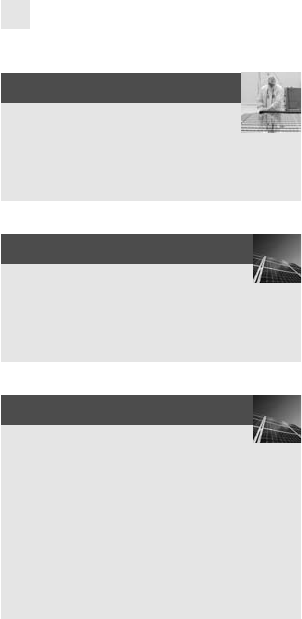
Connecting batteries requires specific cables as
conductors. According NEC Article 690.74, flexible wire must
be no smaller than 2/0 AWG.
Charge Controllers
Charge controllers are installed in PV systems to properly reg-
ulate the flow of energy and thwart battery overcharging. The
charge controller also opens the circuit to array from the bat-
tery when the battery has been fully charged. As a means to
dump the power when this occurs, some charge controllers
can divert output from the array to another load, such as a
water heater.
Charge controller manufacturers publish specific input
voltage and current-rating maximums. PV arrays are not sup-
posed to generate more voltage or current than the charge
controller. The charge controller’s continuous current rating
has to be more than 125 percent of the short-circuit output
current of a PV array. The maximum charge controller input
voltage should be greater than the PV system’s max-
imum voltage.
NEC Article 690.15 requires all PV system component
input and output conductors to have disconnects. That guide-
line also insists that PV systems be able to be disconnected from all electrical
equipment.
NEC Article 690.17 requires that the disconnect is able to open under load
and be listed with “an interrupting rating sufficient for the nominal circuit voltage
and the current that is available at the line terminals of the equipment.” [690.17]
Charge controller output should be less than or equal to input current, however,
the MPPT charge controller is an exception. For some MPPTs, output voltage can
exceed the input voltage. This provides sufficient voltage to charge batteries when
the temperatures reduce module voltage. Some MPPT controllers will allow you
to string modules usually to up to 150V, with 600 V units becoming available in
the market. Check the manufacturer’s materials about MPPT maximum output
voltage and current.
Good charge controllers use temperature sensors in their operation. The sen-
sors are attached to the battery. When there is more than one battery, sensors
should be placed between two batteries, where they get the best temperature
reading. The temperature sensor should be attached to the batteries per the man-
ufacturer’s instructions to ensure that the charge controller uses the appropriate
voltage based on battery temperature factors.
TECH TIPS
Use batteries with higher amp
ratings rather than connecting multiple
lower amp batteries in parallel.
NOTE
Diversion charge controllers are
appealing because they do not waste
output. They move the output to other
loads. However, you must have a load
that can use the energy in a non-
electrical manner. One example is water
heating.
NOTE
Welding cable is not acceptable for PV
system battery connection, per NEC
regulations.
168 ADVANCED PHOTOVOLTAIC INSTALLATIONS
..................Content has been hidden....................
You can't read the all page of ebook, please click here login for view all page.
